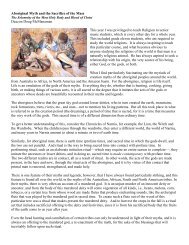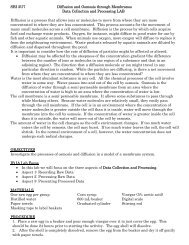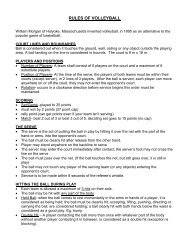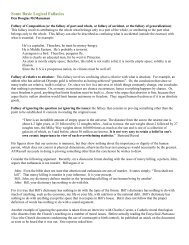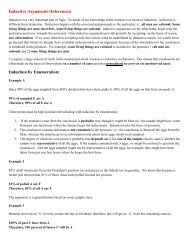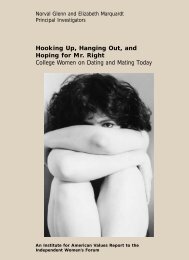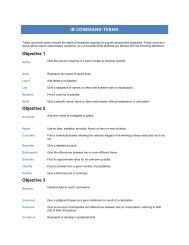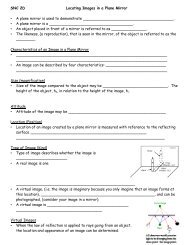Creative Intuition
Creative Intuition
Creative Intuition
You also want an ePaper? Increase the reach of your titles
YUMPU automatically turns print PDFs into web optimized ePapers that Google loves.
<strong>Creative</strong> <strong>Intuition</strong>Deacon Douglas McManamanFrench Thomist Philosopher Jacques Maritain argues that creative or poetic intuition, which is the kind of knowledge at theroot of all great art, is a type of connatural knowledge (a sympathetic or congenial knowledge). In other words, it is not atheoretical knowledge, such as philosophy, or physics, mathematics, etc.The artist is given, in his creative intuition, a non-conceptual knowledge of the things of the world and their secrets, preciselyin order to reveal his most secret being in a work that he produces. This creative intuition arises as a result of the impact hereceives from reality in the unconscious life of the spirit and in the depths of his subjectivity. The following is an attempt tounpack this idea.We need to keep in mind that “truth” in art is not so much a conformity between what is in the imagination and what is inreality; rather, it is a conformity between what is in the work produced and what is in the creative intuition of the artist. Iftruth in art were merely the conformity between what is in the imagination and what is (reality), then the more that a paintingreplicates the scene or whatever is being depicted, the better the art. In other words, the more a work approaches the accuracyof a camera, the better it is. But this is not the case. We know this because the goal of art is to produce a beautiful work, andbeauty is that which, when seen, pleases. Exact replicas are not always the most pleasing. Consider the painting below (theWhite Village, by A.J. Casson). Clearly, Casson was not trying to produce an exact replica, and there is much more there, inthat work, than what a good camera would capture.Now, recall the principle of causality: the effect cannot begreater than the cause. We might say that the source of thework is the village itself on a bright sunny morning. But thereis much more here, in this work, than in the external sceneitself. From where did the rest come from? It came from thevery depths of the artist himself, that is, from the very depthsof his subjectivity or his unconscious mind. The scene is alivein him, for he is a living being, and when he knows the objectoutside of him, it exists in him as part of him, in an immaterialway. Thus, it is alive in him. But it is not merely alive in him“intellectually”. It is within him who is also a being whoimagines, senses, desires, remembers, etc.Allow me to attempt to provide some understanding of whatthis creative intuition really is. First, we only become aware of ourselves when we are in the act of knowing somethingoutside of ourselves, like that village before us on a bright sunny morning. This self-knowledge is a knowledge of ourselvesas subject, not object. I acquire a sense of self, that is, self-consciousness (subjectivity), in knowing something other thanmyself (object).If I had no awareness of myself as subject, I could not possibly know the object before me—that is why computers don’tknow, for they are not subjects, but merely artifacts or products of technology (they are pure objects, not subjects whopossess knowledge). Now to explain this, we need to keep in mind that in knowledge, knower and known becomeidentical. The mind becomes the thing it knows in an immaterial way. The essence of that being outside my mind also existsintentionally within my mind (“treeness” is in me as well as in the tree). The concept is in me as a formal sign—it is not theconcept that I know, but the actual thing outside my mind by means of the concept (the concept is that through which I knowthe object before me). I am myself and I am that being (not physically, but intentionally or immaterially) at the same time,and because my principal power (which is my mind) is immaterial, it is capable of complete self-reflection (as opposed topartial self-reflection). I, who have become that tree immaterially, without ceasing to be myself, am reflected back uponmyself completely and immediately, and so I know simultaneously both that thing and myself who is knowing that thing,because they have become one in the act of knowledge, and I grasp this (subject and object) in the one act of knowing thatthing outside my mind.
What I also know in knowing that beautiful scene before me are my own memories and emotions that arise as a result ofbeholding that beautiful scenery before me, whatever it might be.Consider the following point about this work of art to theleft. There is a world of memories and emotions packedinto this painting. For the human person, intelligence isalways linked to sensation, both internal and external.There is no pure sensation in the human subject, as there isin the brute animal. I sense, but I am intellectually aware(conscious) of what I am sensing, so intelligence isimmediately and simultaneously involved in sensation,both external and internal. In other words, I am sensingexternally, and at the same time am sensing internally, thusI am interpreting and remembering, and I am intellectuallyaware of what I am sensing. There is no “animal”sensation, animal imagination, followed later byintelligence. My sensation (external and internal) occurswithin intelligence, that is, intelligence in me is permeatedwith sensation. It is an intelligent being that senses and imagines. This is human sensation. Brute animals indeed sense, butthere is no accompanying intelligence or intellectual consciousness, only a vague sense consciousness. When we sense,however, what we sense is intelligible as a result of the intellect. Hence, it is a certain kind of intelligence that human beingspossess, namely an intelligent sensing.Now, the senses exist for the intelligence (and the nutritive powers existfor the sense and intellective powers). All that is below exists for thehigher. I sense in order to know the nature of a thing. But I don’t senseoutside of intelligent activity. As was said, there is no “raw” sensationfor you or me; rather, there is an intelligent agent who is sensing. Nowthere is a common root or interior source of this knowledge, and it is inthe very essence of the soul. This root is where the emanation ofintelligence, sensation, and imagination all originate. Imagine an Easterlily. The white petals that stem from a common source and spread outlike a trumpet represents intelligence (the outward bell shaped directionis a good representation of universal concepts).The point at the summit of the lily represents the essence of the soul.The petals that surround the stigma and the anthers represent the intellector reason emanating first from the soul. Next is the yellow anthers in thecenter which emerge from the first surrounding layer or petals, and thisrepresents the imagination, emanating from the soul via the intellect (man’s intellect is a sensing intelligence). The stigma inthe very center amidst the yellow anthers, represent the external senses, emanating from the soul through the imagination.Note that in the order of time, sensation is the beginning. But there is no sensation without internal sensation, and externalsensation exists for the sake of internal sensation, and internal sensation exists for the sake of intelligence.The belled end of the petals that forms a circle represents the world of concepts explicitly formulated. The second circle, theanthers surrounding stigma, represents the world of images explicitly formulated. As Maritain writes: “This is the world ofthe achievements of Imagination as stirred by, and centered upon, the actual exercise of External Senses and held in unity byit: in other words, as engaged in the process of sense perception and used for practical purposes in the current activities ofman in the waking state.” The stigma in the middle represents the data provided by the external senses. Note that thisintuitive data becomes sense perception when interpreted through the instrumentality of the synthetic sense, sense memory,imagination, instinct, etc.
The life of sensation, imagination, and intelligence, are all rooted in the single point at the top, that is, within the spiritualunconscious, where there is no explicit formulation of concepts and/or images. There is, rather, implicit and unformulatedintellectual knowledge. But keep in mind, the external and internal senses proceed from that very origin as well. Thisknowledge, therefore, is not a pure intellectual knowledge in its unformulated state, but an intellectual/sense knowledge in itspre-conscious and unformulated state.In this point, there is another kind of life, a cognitive and productive life. It is cognitive, but not explicit (like the formulatedconcepts of philosophy or science), and it is productive or creative. It tends towards creative expression. An intuition occurshere, an unconscious one that involves imagination, memory, emotions, appetite, intelligence, etc. It is a living intuition thattends toward a visible or audible expression. It wishes to be known, to be seen, to be heard, thus it tends towards explicitexpression. It is rich with meaning, and so it requires more than simple words can convey.If this intuition is successfully expressed visually, it will inspire awe, it will open the viewer to the soul of the artist, andthrough him, to the world he beholds. We will receive something of his creative and poetic intuition, that is, we will bebrought into some sort of contact with this common point in his spiritual unconscious mind from which emanate hisintellective, imaginative and sensorial powers. If it is expressed in words, it will be a kind of discourse, that is, he will havesomething to say, and what he has to say can only be expressed in a certain way, using the right words with the right soundsand rhythms. If what he beholds, or if what is living inside of him, in the depths of his spiritual unconscious, is expressed inmusic, we will be moved in a certain way. We will be raised up, so to speak, or lifted up, picked up. We will experience asort of exit from the self (ec-stace), that is, an ecstasy. We will enter into a movement, and we might be moved “to move”with the music, to dance perhaps.It should be evident that art is about the production of a work that lifts; for beauty lifts us higher, takes us up off the ground(the soil, the realm of the human) and allows us to enter into, or allows us to strive to enter into, a supra-human ortranscendent realm. It may not take us into that realm, but it tries to. There is something in that realm of the spiritualunconscious that longs for that realm. Man yearns to lose himself in something higher than himself, and art is a witness tothat very tendency.In this sense, art is really a search and yearning for Eden. If the icon is really what iconographers say it is, namely a doorwayto the sacred, then perhaps it can be argued that it is in the icon that art has achieved what it has always longed for.Knowledge on the Side of the ViewerIn order to appreciate a work of art, such as a painting, I will argue that certain conditions in the viewer need to be in place.First, one must have an intellect. Brute animals do not appreciate art; for what is expressed in a work of beauty is an intuitionthat is cognitive and productive, even if it is pre-conscious. Moreover, the viewer must have certain experiences. There’s asense in which Plato’s “all knowledge is reminiscence” is true when it comes to a work of art or literature—albeit notentirely. There are certain works of art that move a person, only because they take him back to a world he once knew. I’mthinking of a painting, a watercolor of a scene in New Jersey—although initially I wasn’t aware that it was New Jersey—, itwas of a back alley behind a row of old houses, as you’d find in the old Italian areas of the city of Toronto. Would I haveappreciated that work as much had I not had the experience of living in a similar neighborhood? Would a child raised in adifferent environment experience the same delight?I remember looking at some abstract art at the Wellington Gallery in Aurora. I started to discuss the work with the owner, amulti-millionaire who buys and sells art. I told him that I don’t quite understand the painting before me, which to meappeared as if it was painted by a regular house painter, dipping the roller into a green paint and applying one stroke to apiece of plywood, then dipping another roller into a yellow paint and applying one square layer next to the green, and so on.The owner pointed out that the painting was worth over $30.000. He did succeed in helping me understand why someonewould want that. He said such a work belongs in a corporate office, that it evokes certain emotions, which in turn will put usin a certain frame of mind. I can accept that, and certainly a wealthy corporation would be able to afford such a piece as that.A Van Gogh or a Byzantine icon would not suit the corporate environment.
But I then showed him some of my works, lettinghim know first that I am a complete amateur. Ishowed him a painting I did for a friend of mine,a painting of his house in winter. I enjoy lookingat that painting every time I see it, because itbrings me back to the many times I’d visit him inthe winter. I’d observe the night lightilluminating the front porch, with the window ofthe lounge next to it, and all the feelings(emotions) that I’ve associated with thosediscussions that took place as well as thefriendship celebrated in that lounge over theyears came back to me. But the owner of thegallery remarked: “Why would I want somethinglike that? It means nothing to me. It meanssomething to you, but not to me.” And there’s asense in which he is right. The work is not wideenough to appeal to a large number of people. To him, it was a painting of a house in winter.A great artist would be able to create a work of beauty that communicates a more universal experience. A Trisha Romance,although highly sentimental, would appeal to more people, since it contains elements that widen it. Perhaps its sentimentalityis the reason we’d argue that Trisha Romance art is not great art. Technically it is excellent, it brings you into the picture,into the town of Niagara on the Lake, for example, but does it liftyou “above the earth”? It is pretty, but is it awe inspiringlybeautiful?Now, it is true that different people will bring different mental andemotional horizons to the work, and so there will be various degreesof appreciation, but a good work of art opens up a world to theviewer, and truly great art lifts a person up towards the source of allthat is beautiful, the Supremely Beautiful. A great artist or writerwill be able to draw the viewer or reader into that world more sothan an amateur, but that world which exists in his creative intuitionis something more than this world. The experience is delightful,because it is beautiful. Great art, however, is more than delightful;it is awe-inspiring.Is there truth there? I would argue that yes, indeed, there is a kind of truth in a great work of art. There is the experience of areal world, a real culture that I (the viewer) am in contact with. Now truth and beauty are properties of being. A great artistwill be able to communicate “the fullness of what is” through his art, certainly not “fully” or completely, but in a way that acamera or straight history (if we are talking about poetry or literature) is unable to do. There is often more to what we knowthan can be expressed scientifically, or through straight historical narrative. There is humor in certain characters that cannotbe adequately reproduced, except through the talent of a great novelist. The truth expressed need not be a moral truth,namely, what “ought to be”, but may simply be limited to “what is”. The more complete that expression, the more pleasingthe work.I remember reading a novel by Norman Mailer, The Executioner’s Song, which depicts the events leading up to and includingthe execution of Gary Gilmore. Mailer was able to draw me into that world with such skill that I couldn’t wait for the novelto be done with, because I found Gilmore’s world so depraved. But it was a very accurate portrayal, one far more true to thefacts than say the television series Criminal Minds. Now, I’d never tasted that world before, so there’s a sense in which allknowledge is not reminiscence. A work can “put knowledge into me”. I have not been to Tuscany, but I have enjoyed thepaintings of Slava Brodinsky. I often wonder whether he has actually helped me to see—what I have been otherwise be



